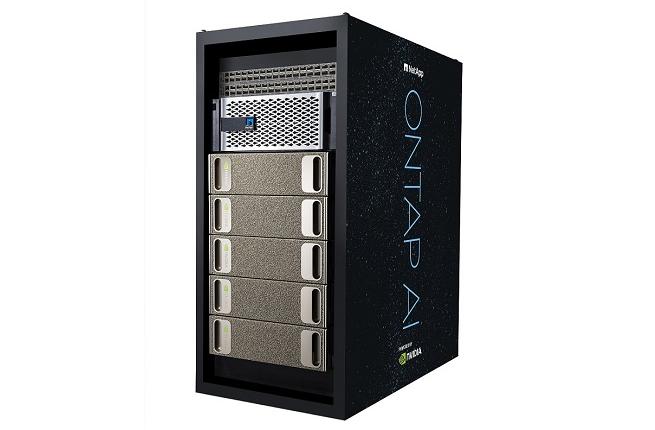Source – albawaba.com
NetApp, the data authority for the hybrid cloud, today introduced NetApp® ONTAP® AI proven architecture, powered by NVIDIA DGX supercomputers and NetApp AFF A800 cloud-connected all-flash storage to simplify, accelerate, and scale the data pipeline across edge, core and cloud for deep learning deployments and to help customers achieve real business impact with AI.
Although many organizations are adopting new AI platforms, tools, and practices, most don’t have enough control over their distributed data stores to ensure that complete, current, and accessible data is available for their AI projects. Success with AI depends on a business’s approach to data. To be effective in today’s AI use cases and future-proof a business for new AI applications, organizations must achieve visibility into and control of their data, from edge to core to cloud.
“Companies of all sizes and across various industries are making significant inroads in using AI to solve real-life problems, especially in the enterprise. However, while very exciting, AI models and workloads are not easy to deploy, and many organizations are struggling,” said Ritu Jyoti, program vice president, IDC. “The NetApp ONTAP AI proven architecture is a powerful solution that will help users accelerate AI-driven business outcomes and overcome deployment obstacles.”
“Developing disruptive AI technology and turning this into breakthrough products and services for our customers is a vital requirement across many markets we work in,” said Monty Barlow, head of artificial intelligence, Cambridge Consultants. “NetApp ONTAP AI powered by NVIDIA DGX supercomputers and NetApp all-flash storage is simplifying and accelerating the data pipeline for deep learning.”
“Organizations everywhere are making significant investments in AI, but they often lack the infrastructure required to optimize their data for AI projects and scale their applications and workflows to create the business impact they expect,” said Octavian Tanase, senior vice president, ONTAP, NetApp. “NetApp’s cloud-connected data solutions and new proven architecture with NVIDIA DGX create a single data environment for AI. This gives customers the control, access, and performance they need to provide the right data at the right time at the right location to their AI applications – all at scale and all integrated, managed, and protected by the NetApp Data Fabric.”
By leveraging the NetApp Data Fabric, ONTAP AI enables enterprises to create a seamless data pipeline that spans from the edge to the core to the cloud. This pipeline integrates diverse, dynamic, and distributed data sources, with complete control and protection. With massive processing power and capacity, ONTAP AI removes performance bottlenecks and enables secure, nondisruptive access to data from multiple sources and data formats.
“The combination of NVIDIA DGX and NetApp all-flash arrays meets the infrastructure challenges of today’s AI deployments,” said Jim McHugh, vice president and general manager of Deep Learning Systems at NVIDIA. “NVIDIA’s leadership in AI and GPU computing, combined with NetApp’s innovation in all-flash storage systems, gives customers a faster way to deploy AI with proven performance and a simplified operations model.”
ONTAP AI is a joint NetApp and NVIDIA proven architecture offering that combines the world’s most powerful GPU solutions with the world’s fastest and most cloud-connected flash systems and software.
Features and benefits include:
- Deploy easily. Get started faster with AI by eliminating design complexity and guesswork.
- Scale without limits. Organizations that are starting out with deep learning can begin with a 1:1 configuration and scale out as their data grows, to a 1:5 configuration and beyond.
- Operate with confidence. High-availability solution design with redundant storage and network and server connections.
An Ecosystem of Solution Partners
ONTAP AI is available through channel partners, including:
“As long as we have partnered with NetApp, their products have been able to adapt to address the challenges around data that come with major technological advances. AI is a key component to building modern applications that are engaging, real time, and distributed. NetApp ONTAP AI and Data Fabric make it easier to leverage data wherever it is, to build and deploy powerful AI-powered applications,” said Mark Kelly, chief strategy officer at ePlus. “ONTAP AI simplifies ongoing operations and accelerates time to results. With our AI expertise and track record in converged infrastructure, we can help customers focus less on infrastructure and more on driving outcomes from their deep learning environments.”
“Customers want an AI solution that allows them to start small and grow. ONTAP AI provides a proven architecture to help them achieve that goal,” said Manohar Vellala, practice manager, Data and Analytics at Groupware Technology. “Our customers can now deploy a powerful, highly available deep learning configuration validated by NetApp and NVIDIA with the headroom to grow with their needs.”
“IAS is excited to be a launch partner for the ONTAP AI proven architecture,” said Amy Rao, CEO of IAS. “Moving large datasets from edge to core or core to cloud is becoming impractical, and customers are looking for ways to maximize data value independent of location. The Data Fabric—combined with NetApp cloud-connected all-flash technology and NVIDIA GPU-assisted compute and all packaged in a prevalidated configuration—gives customers the choice, control, efficiency, and availability required for deep learning environments.”
“Customers deploying AI and deep learning are looking for ways to reduce their time to outcomes. A highly available and powerful deep learning environment ensures that data scientists stay productive,” said Bob Olwig, vice president of Corporate Business Development, WWT. “ONTAP AI is a proven architecture from NetApp and NVIDIA that complements WWT’s broad portfolio of solutions and services for deep learning, giving customers an AI stack that can be implemented quickly with higher efficiency and lower risk.”
